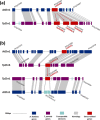Life at the extreme: lessons from the genome
- PMID: 22390828
- PMCID: PMC3439964
- DOI: 10.1186/gb-2012-13-3-241
Life at the extreme: lessons from the genome
Abstract
Extremophile plants thrive in places where most plant species cannot survive. Recent developments in high-throughput technologies and comparative genomics are shedding light on the evolutionary mechanisms leading to their adaptation.
Figures


References
-
- Komarkova V, Poncet S, Poncet J. Two native antarctic vascular plants, Deschampsia antarctica and Colobanthus qulitensis: a new southernmost locality in the Antarctic peninsula area. Arctic Alpine Res. 1985;17:401–416. doi: 10.2307/1550865. - DOI
-
- Willert DJ, Eller BM, Werger MJA, Brinckmann E. Desert succulents and their life strategies. Vegetatio. 1990;90:133–143. doi: 10.1007/BF00033023. - DOI
-
- Flowers TJ, Troke PF, Yeo a R. The mechanism of salt tolerance in halophytes. Annu Rev Plant Physiol. 1977;28:89–121. doi: 10.1146/annurev.pp.28.060177.000513. - DOI
-
- Royal Botanic Gardens, Kew: Salt Tolerance (eHALOPH). http://data.kew.org/sid/halophyte.html http://data.kew.org/sid/halophyte.html
Publication types
MeSH terms
Substances
LinkOut - more resources
Full Text Sources

